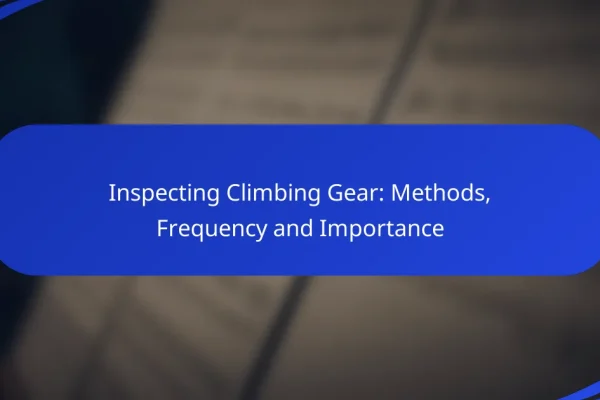
Harness Safety Ratings: Essential Knowledge for Climbers
Understanding harness safety ratings is essential for climbers, as these ratings, established by recognized standards…
Rock climbing requires specific gear to ensure both safety and performance, whether you're scaling outdoor cliffs or tackling indoor walls. Essential items include climbing harnesses, shoes, helmets, and ropes, each designed to meet the unique demands of different climbing environments. Understanding the purpose and features of each piece of equipment is crucial for a successful climbing experience.

Understanding harness safety ratings is essential for climbers, as these ratings, established by recognized standards like UIAA and CE, indicate the strength and reliability of the equipment. By choosing harnesses that meet these safety criteria, climbers can ensure they are using reliable gear that can withstand the forces experienced during falls, ultimately enhancing their safety…

Inspecting climbing gear is essential for ensuring safety and optimal performance during climbs. By conducting both visual checks and functional tests, climbers can identify wear and tear that may compromise gear reliability. It is recommended to inspect personal gear before each use and perform a thorough examination at least once a year to prevent potential…

Choosing the right climbing shoes is crucial for achieving the perfect balance of fit, comfort, and performance on the rock. A snug yet comfortable fit, along with thoughtful design features such as toe box shape and materials, can greatly enhance your climbing experience. Prioritizing these elements will ensure you can tackle various terrains with confidence…

Selecting the right climbing harness is crucial for beginners, as it directly impacts comfort, safety, and overall climbing experience. Key factors to consider include fit, adjustability, and essential safety features. Popular options like the Petzl Corax and Black Diamond Momentum offer a balance of affordability and performance, making them ideal choices for new climbers. What…

Breaking in climbing shoes is essential for achieving optimal comfort and performance on the rock. By employing various techniques, climbers can ensure their shoes mold to their feet without causing excessive discomfort. Selecting the right brand, such as La Sportiva or Scarpa, can also significantly enhance the overall fit and support needed for successful climbs….

When climbing in hot weather, choosing a helmet with effective ventilation features is essential for comfort and safety. Look for designs that incorporate ample vents, lightweight materials, and moisture-wicking liners to enhance airflow and reduce sweat buildup. These elements not only improve comfort but also help maintain focus during challenging climbs in warm conditions. What…

When choosing a climbing helmet, it’s essential to look for safety certifications such as UIAA, CE EN 12492, and ASTM F2040, which indicate that the helmet has met rigorous performance standards. These certifications ensure that the helmet provides adequate impact protection and durability, crucial for climbers facing potential falls or accidents. Reputable brands like Petzl,…

Choosing the right climbing rope is essential for ensuring safety and enhancing performance during your climbing adventures. Factors such as style, length, weight, and material play a crucial role in selecting the appropriate rope for your specific needs, whether you’re tackling sport routes or alpine challenges. Understanding these elements will help you make an informed…

Lightweight climbing helmets are essential for climbers seeking a balance of comfort, durability, and performance. Models like the Petzl Meteor and Black Diamond Half Dome offer excellent fit and ventilation, allowing for extended wear without sacrificing safety. When choosing a helmet, consider features such as adjustable fit and effective ventilation to enhance your climbing experience….

When tackling multi-pitch routes, selecting the right climbing harness is crucial for ensuring comfort and safety. The best options prioritize features such as weight, adjustability, and gear loop capacity, allowing for a secure fit and easy access to essential gear. By carefully evaluating these elements, climbers can enhance their performance and enjoy a more secure…
For outdoor climbing, essential gear includes a climbing harness, climbing shoes, a helmet, a chalk bag, and a rope. Each piece of equipment plays a crucial role in ensuring safety and performance while navigating various climbing routes.
A climbing harness is vital for securing yourself to the rope and for connecting with other gear. Choose a harness that fits snugly but comfortably, allowing for movement without restriction. Look for features like adjustable leg loops and gear loops for added convenience.
When selecting a harness, consider the type of climbing you will be doing. Sport climbing harnesses are typically lighter and more streamlined, while trad climbing harnesses offer more padding and gear storage. Always check for safety certifications, such as UIAA or CE standards.
Climbing shoes provide the necessary grip and support for your feet while climbing. A good pair should fit tightly without causing pain, allowing for maximum sensitivity on footholds. Look for shoes with a rubber sole that offers excellent traction.
Consider the type of climbing you'll be doing when choosing shoes. Aggressive shoes are best for sport climbing, while moderate shoes are suitable for multi-pitch climbs. It's often helpful to try on several pairs to find the best fit for your foot shape.
A climbing helmet protects your head from falling rocks and impacts during a fall. Ensure the helmet fits securely and comfortably, with adjustable straps for a snug fit. Look for lightweight options that meet safety standards like UIAA or CE.
When selecting a helmet, consider features such as ventilation, weight, and whether it has a removable liner for easy cleaning. A good helmet should provide ample coverage without obstructing your vision or hearing.
A chalk bag helps keep your hands dry and improves grip on holds. Choose a bag that is easy to access and has a secure closure to prevent chalk from spilling. Look for a bag with a belt or clip for convenient attachment to your harness.
When using a chalk bag, practice good chalk etiquette by minimizing spills and keeping your area tidy. Some climbers prefer chalk balls for less mess, while others opt for loose chalk for maximum coverage.
The rope is a critical component for safety in climbing, providing a lifeline in case of a fall. For outdoor climbing, dynamic ropes are preferred as they stretch to absorb the impact of a fall. Look for ropes that meet safety standards and are appropriate for your climbing style.
Consider the rope's diameter and length based on your climbing needs. A diameter of 9.5 to 10.5 mm is common for sport climbing, while lengths typically range from 60 to 80 meters. Regularly inspect your rope for wear and damage, and retire it if you notice significant fraying or other issues.
Essential rock climbing gear for indoor climbing includes specialized equipment designed for safety and performance. Key items are indoor climbing shoes, a belay device, and a climbing harness, each serving a critical function in ensuring a safe and enjoyable climbing experience.
Indoor climbing shoes are designed to provide a snug fit and optimal grip on artificial holds. They typically feature a rubber sole that enhances friction and allows for precise foot placements. When selecting shoes, consider factors like fit, stiffness, and closure type (Velcro or laces) to match your climbing style.
For beginners, a moderate shoe with a relaxed fit is often recommended, while more experienced climbers may prefer a tighter, performance-oriented shoe. It's advisable to try on several pairs to find the best fit, as comfort is crucial for longer climbing sessions.
A belay device is a critical piece of safety equipment used to control the rope during climbing. It allows the belayer to manage the rope's tension and catch a fall effectively. Common types include tube-style devices and assisted-braking devices, each offering different levels of control and ease of use.
When choosing a belay device, consider compatibility with the rope diameter and your experience level. Assisted-braking devices can be beneficial for beginners, as they provide added safety features. Always practice using your belay device before climbing to ensure proficiency.
A climbing harness is essential for connecting the climber to the rope and ensuring safety while climbing. It typically consists of a waist belt and leg loops, designed to distribute weight evenly. Look for a harness that fits well and is comfortable for extended wear.
When selecting a harness, consider features such as gear loops for carrying equipment and adjustable leg loops for a customizable fit. For indoor climbing, a lightweight and minimalistic harness is often sufficient, but ensure it meets safety standards for climbing activities.
Choosing the right climbing rope involves understanding your climbing style, the type of climbing you'll do, and the specific features of the ropes available. Key factors include the rope's type, diameter, and length, which all influence performance and safety.
Dynamic ropes are designed to stretch under load, making them ideal for climbing as they absorb the energy of a fall. Static ropes, on the other hand, have minimal stretch and are better suited for activities like rappelling or rescue operations where elasticity is not required.
When selecting between dynamic and static ropes, consider the climbing environment. For sport climbing and traditional climbing, dynamic ropes are essential, while static ropes are preferable for caving or hauling gear.
The diameter of a climbing rope affects its weight, durability, and handling characteristics. Ropes typically range from about 8.5 mm to 11 mm; thinner ropes are lighter and easier to handle but may wear out faster and have lower fall ratings.
For sport climbing, a diameter of 9.5 mm to 10.5 mm is common, balancing weight and durability. For trad climbing or heavier use, consider thicker ropes for added safety and longevity.
Rope length is crucial for ensuring you have enough material for your climbs. Common lengths range from 50 meters to 80 meters, with longer ropes providing more versatility for various routes.
When choosing a length, consider the height of the routes you plan to climb and the potential for rappelling. Always opt for a length that exceeds the height of your longest climb to ensure safety and flexibility.
The best brands for climbing gear are known for their quality, durability, and innovation. Top choices include Black Diamond, Petzl, Scarpa, and La Sportiva, each offering specialized equipment that caters to various climbing needs.
Black Diamond is a leading brand in the climbing industry, renowned for its wide range of gear, including harnesses, carabiners, and climbing protection. Their products are designed with input from professional climbers, ensuring high performance and safety.
When choosing Black Diamond gear, consider their reputation for durability and user-friendly designs. Popular items include the Black Diamond Momentum harness and the Camalot C4, which are favored for their reliability and ease of use.
Petzl is another top brand, especially known for its innovative climbing hardware and headlamps. Their gear emphasizes safety and functionality, making them a favorite among both recreational and professional climbers.
Key products from Petzl include the GriGri belay device and the Petzl Corax harness. These items are designed to enhance climbing efficiency and safety, with features that cater to various climbing styles.
Scarpa specializes in climbing footwear, offering a variety of shoes suited for different types of climbing, from bouldering to sport climbing. Their shoes are designed for comfort, performance, and precision on the rock.
When selecting Scarpa shoes, consider models like the Drago for bouldering or the Vapor V for sport climbing. Each model is engineered to provide the right balance of support and sensitivity, which is crucial for effective climbing.
La Sportiva is renowned for its high-quality climbing shoes and outdoor footwear. Their products are crafted with advanced materials and technologies to ensure optimal performance in various climbing conditions.
Popular La Sportiva models include the Theory for sport climbing and the Miura for precision. These shoes are well-regarded for their fit and grip, making them ideal choices for climbers looking to enhance their performance on challenging routes.